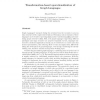Free Online Productivity Tools
i2Speak
i2Symbol
i2OCR
iTex2Img
iWeb2Print
iWeb2Shot
i2Type
iPdf2Split
iPdf2Merge
i2Bopomofo
i2Arabic
i2Style
i2Image
i2PDF
iLatex2Rtf
Sci2ools
116
click to vote
GG
2008
Springer
2008
Springer
Transformation-Based Operationalization of Graph Languages
Graph Languages1 emerged during the seventies from the necessity to process data structures with complex interrelations. Nowadays, various variants of these languages can be found for querying [1][2], in-place transforming [3][4], and translating graph structures [5][6]. Still, new graph languages supporting different paradigms and usage scenarios are proposed regularly. In fact, languages tailored for a dedicated application domain can be restricted to a concise and clear syntax representation, thus reducing effort to learn and apply them. Effectively aiding the development of graph languages, even though considering the already existing ones, therefore remains an important working topic. Constructing specialized graph languages, considering them as special case of domain-specific modeling languages, is supported by various frameworks and socalled Meta-CASE tools, e.g. [7]. Operational implementations of these languages is usually achieved by customizing template-based code gener...
GG 2008 | Graph Language | Modeling Languages | Specialized Graph Language | Theoretical Computer Science |
Related Content
| Added | 09 Nov 2010 |
| Updated | 09 Nov 2010 |
| Type | Conference |
| Year | 2008 |
| Where | GG |
| Authors | Erhard Weinell |
Comments (0)

